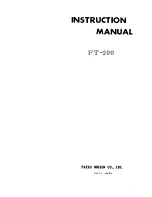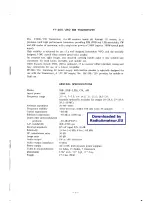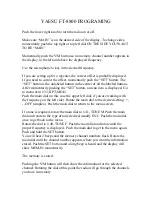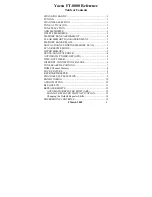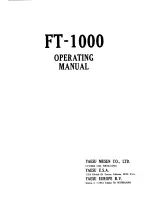
Page 2-8
V10/V7.5/V5/V3.5 Installation and Operation Manual
Issue 3.5
Section 2 Preparation for Use and Installation
2.2.9.2 Power Consumption
Power consumption varies depending on
the transmitter’s mode of operation
(analog/hybrid/all-digital). If the transmitter
configuration is a dedicated analog,
hybrid, or all-digital transmitter, use Table
2-2 to determine the actual input power
requirements. If the transmitter
configuration is variable (between all
modes), use the analog (FM mode) power
source capacity information. Nautel
recommends using the highest current
values (FM mode) when determining wire
ratings.
Nautel recommends the ac power source
have a 25% over-capacity to ensure
adequate regulation.
2.2.9.3 External Ac Switching
All current carrying conductors from the ac
power source must be controlled by an
external switching box located in close
proximity to the transmitter. This switch
box should be clearly marked
TRANSMITTER EMERGENCY ON/OFF
SWITCH
.
See Table 2-2 for current ratings
and suggestions that should aid in
selecting a circuit breaker and associated
input wiring.
2.2.10 Antenna System
The antenna system must present
50 ± j0
Ω
impedance at the carrier
frequency. The transmitter will function
while operating into a maximum VSWR of
1.5:1, but overall system performance will
be degraded. Circuitry within the
transmitter will prevent damage to the
transmitter from high VSWR loads.
2.2.10.1 RF Feed Cable
The RF feed cable interconnecting the
transmitter and the antenna system
should be a suitably rated coaxial cable.
As a standard, the RF output is configured
to accept a non-gas type 3-1/8 inch
(V10/V7.5) or 1-5/8 inch (V5/V3.5) EIA
flange (male) connection (appropriate
male inner connector not provided with
the transmitter). Optional EIA connections
are available (see below):
V10/V7.5: 7/8 or 1-5/8 inch also available
V5/V3.5: 7/8 or 3-1/8 inch also available
2.2.11 RF Drive Source(s)
The RF drive source type and power level
depends on the transmitter’s operational
mode (all-digital/hybrid/analog).
An exciter (or dual exciters) provides an
IBOC (phase modulated OFDM) signal
and/or an FM carrier in the 87.5 to
108 MHz band.
The exciter’s output power should be
20 W (10 W) for analog configured
V10/V7.5 (V5/V3.5) transmitters or 10 W
(5 W) for digitally configured V10/V7.5
(V5/V3.5) transmitters operating in analog
mode.
The transmitter cabinet accepts one or
two Nautel FM exciters. Each exciter must
have an external on/off interlock or RF
mute capability. The transmitter provides
a set of form C contacts on the remote
interface PWB (A44) for each exciter’s RF
mute control. Exciter A’s contacts are
between TB2-1 and TB2-3 (N/C) or TB2-2
and TB2-3 (N/O). Exciter B’s contacts are
between TB2-4 and TB2-6 (N/C) or TB2-5
and TB2-6 (N/O). If the exciter needs an
open on its interlock terminals to not be
muted, connect to N/O (normal operation
is open). If the exciter needs a short on its
interlock terminals to not be muted,
connect to N/C (normal operation is
closed).
2.2.11.1 Digital (IBOC) Operation
For IBOC operation, the exciter uses
Exgine technology. An exporter provides
the digital component directly to the
exciter via an Ethernet connection; the
transmitter requires no additional
connection.
Содержание V10
Страница 2: ......
Страница 10: ......
Страница 20: ......
Страница 52: ......
Страница 54: ......
Страница 55: ...Dimensions inches mm Dimensional Information V10 V7 5 Transmitter Issue 3 5 Not to Scale Figure 2 8 Page 2 29 ...
Страница 56: ......
Страница 57: ...Dimensions mm inches Dimensional Information V5 V3 5 Transmitter Issue 3 5 Not to Scale Figure 2 9 Page 2 30 ...
Страница 58: ......































